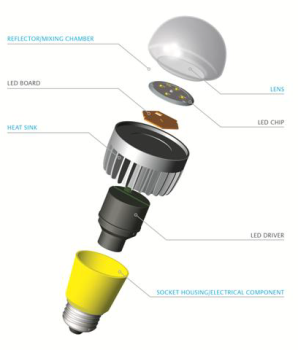Here at the Strategies in Light event, SABIC’s Innovative Plastics business (booth #949) is featuring a wide range of high-performance thermoplastic materials for light-emitting diode (LED) lighting that can help customers address today’s top challenges: enhancing designs and aesthetics, extending useful life, greater sustainability and improving cost-effectiveness.

SABIC’s materials provide the fresh and effective solutions lighting manufacturers are looking for when developing LED lenses and light guides, diffusion covers, lamps/bulbs, tubes, reflectors and heat sinks. This comprehensive and growing product offering demonstrates the company’s deep understanding of customer needs – particularly in the retrofit LED space – and its ability to deliver materials to meet these requirements.
“The LED market remains exceptionally dynamic, calling for highly adaptable material technologies that can enable rapid design changes, support higher-efficacy LED designs and help drive down persistent cost barriers to adoption,” said David Wildgoose, general manager, Engineering Resins, Innovative Plastics. “These diverse factors call for a wide choice of high-performance materials – and SABIC is proud to offer one of the broadest portfolios available. Together with our exceptional application development, technical support and color services, SABIC continues to engineer innovative materials to keep pace with the fast-changing LED landscape.”
Broad Material Technologies for Lighting
SABIC is showcasing its LEXAN™ LUX family of resins featuring sustainable non-brominated, non-chlorinated flame retardant (FR) technology. These polycarbonate (PC) resins provide a choice of transparency for high optical clarity in spotlights and street lamps, or customizable diffusion levels that are especially valuable for architectural applications and retrofits in residential settings. LEXAN LUX-C resins, for example, have transmission of about 91 percent at 1mm thickness.
BritePointe’s HyBeem high-bay LED downlight, on display at the SABIC booth, provides the lighting equivalence of a conventional 400 watt high-intensity discharge (HID) metal halide (MH) or high-pressure sodium (HPS) vapor light source in a similar form factor with substantial power savings and a service life of up to 50,000 hours. These downlights use LEXAN resin for the top cover of the fixture and the lens.
In contrast, the diffusion capabilities of LEXAN resin are highlighted in a recessed architectural linear fixture with an extruded LED lens. For this application, diffusion is used to scatter the light from the LEDs and create attractive architectural aesthetics for commercial offices and other high-end environments.
LEXAN LUX grades are specially designed for manufacturing optical parts requiring easy flow properties combined with very high light transmission and color stability and transmission stability over time. They are an excellent material of choice for automotive and non-automotive lighting applications such as light guides and lenses. There will be an interactive display in the SABIC booth to demonstrate diffusion options and how they perform with LED assemblies.
Also within the LEXAN™ LUX portfolio, SABIC offers reflective PC. SABIC will be showcasing highly reflective examples showing white reflectivity around 97 percent. These materials offer alternatives to painted metal and reflective films.
The company is also promoting two copolymer technologies: LEXAN XHT resin provides higher heat stability than standard PC, and LEXAN SLX resin with enhanced ultraviolet (UV) stability provides outstanding weatherability, impact resistance and an F1 rating for outdoor lighting applications.
Another family of SABIC materials, VALOX™ and VALOX iQ™ resins, also offer non-brominated, non-chlorinated FR performance meeting UL94 standards and may be suitable for electrical applications. VALOX iQ resins, which use post-consumer recycled material, add another sustainability benefit.
New Approaches to Thermal Management
As demand rises for LEDs with higher intensities and longer life spans, there is a corresponding need for better thermal management. These LEDs require efficient heat sinks to sustain their performance over an extended lifespan. However, as miniaturization reduces the size of LED fixtures, lighter-weight materials with greater design flexibility, including the ability to mold thin-wall parts, are needed.
Another challenge to conventional heat sink materials such as die-cast aluminum is sustainability. Manufacture of aluminum heat sinks contributes significantly to upstream waste and energy consumption. A recent report by the U.S. Department of Energy stated, “The greatest environmental impact after energy-in-use for the LED sources comes from manufacturing the aluminum heat sink…”1
KONDUIT™ compounds can replace aluminum or complement it in new heat sink designs, particularly for lower-wattage LED bulbs. A product environmental study conducted by SABIC in partnership with GreenOrder, a leading sustainability consulting firm, showed that LED heat sinks made with KONDUIT compounds instead of die-cast aluminum can typically avoid 87 percent of the energy consumed and greenhouse gas emitted during manufacturing and fabrication. Heat sinks using KONDUIT compound with aluminium inserts avoid 69-77 percent of the energy consumed and 67-78 percent of the greenhouse gas emitted, according to the study. At the booth SABIC is showing samples of KONDUIT compound overmolded onto aluminum.
Lightweight SABIC KONDUIT electrically isolative compounds, which can be injection molded, also offer greater design freedom than aluminum. A key benefit of the SABIC material is molded-in color, which avoids the need for secondary painting.
The company is displaying a MR16 LED replacement lamp featuring a heat sink molded from KONDUIT compound. This lamp offers about five times the energy efficiency of a similar halogen MR lamp. The manufacturer was able to mold the lamp in a white color and eliminate a secondary painting process.